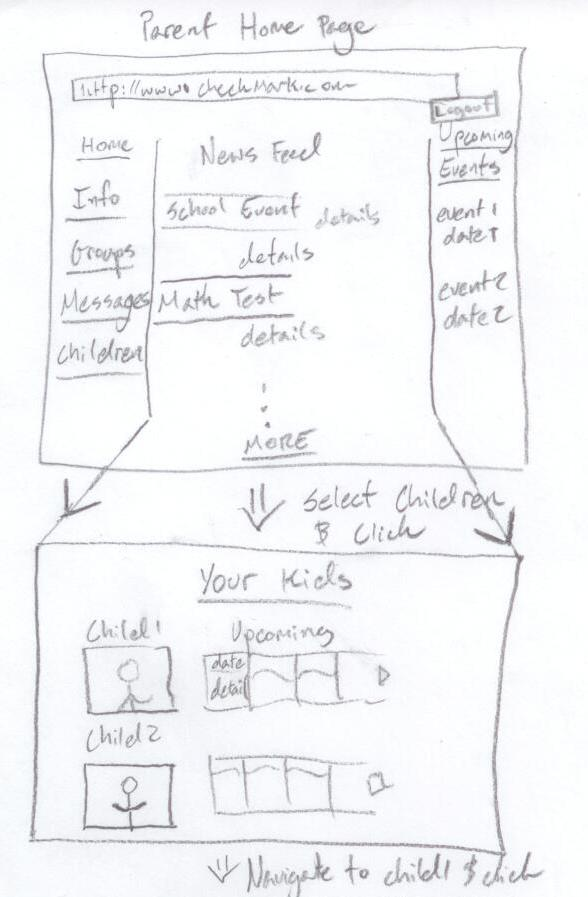
|
Parent Home View
Busy Becky begins at a parent homepage. Here she experience an interface very similar to the most popular social networking sites. Only the center frame changes (as well as appearing and disappearing dialogues). Busy Beck can immediately view a stream of events relating to both of her children and their respective schools.
Becky decides to navigate to the Children button and the middle frame switches to a frame displaying her children with a stream of events relating specifically to events that affect each children. Becky can hover an event, bring up more details as well as click the arrow to the side to view more events (most current events displayed first).
Action: From the main parent view, Busy Becky has immediate access to a variety of information and decides to click on children, to inspect their event streams separately.
Description: The biggest functionality of this interface is to enable parents to teachers to edit and add to a student profile, allowing them to easily communicate and check up on their children/students. The home views for each provide a news feed which displays events chronologically that are associated with the students associated with a parent/teacher. This way both parents and teachers can immediately view the most important information despite the possibility (and certainty for teachers) of dealing with more than one student. |
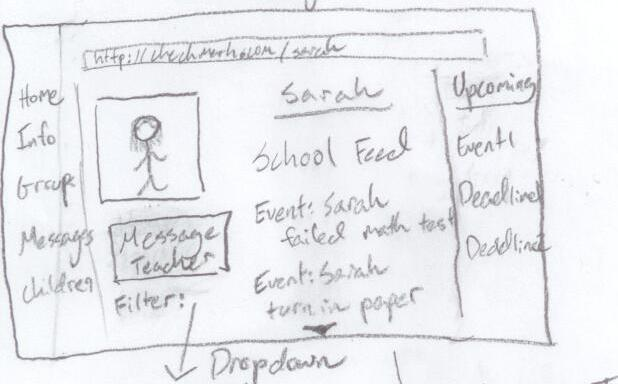
|
Student Profile View
Busy Becky then clicks on the picture of her daughter, Sarah. Here, she can view a more complete stream of events relating to Sarah and then filter them by type of event such as assignments, study sessions, deadlines, and exams. Once again, hovering over any event brings up more details about the event.
Action: After navigating to her daughter's profile page, Busy Becky can choose to message a teacher as well as view more detailed information about Sarah including grades, attendance, etc. Noticing an event about "Sarah failing a math test", Becky chooses to message the teacher.
Description: Using conversations and messages allows parents and teachers to communicate with each other directly and privately. Also, only parents and teachers associated with a certain student profile can view it, providing another layer of privacy. |
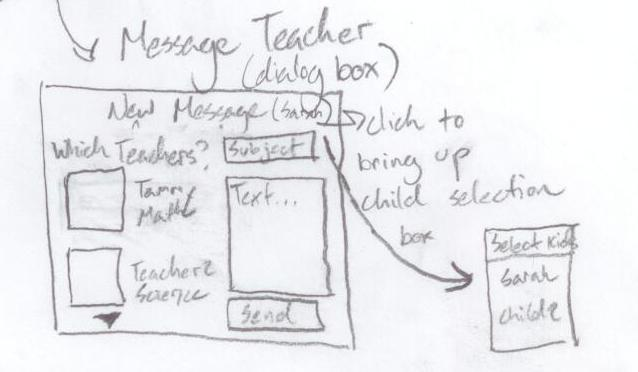
|
Message Dialogue
After viewing her daughter's events and seeing that Sarah failed her math midterm, Busy Becky decides to send a message to Sarah's math teacher, Teacher Tammy by selecting the Tammy icon which highlights after selection. Becky also has the option of sending a message to multiple teachers, but this time, she just chooses Tammy. Becky then enters a message and sends the message by typing in the textbox and clicking the "Send" button.
Action: Using this message dialogue box, Becky can initiate a conversation easily by selecting a recipient and subject, entering a message, and clicking send.
Description: Messages in this interface allow two parties connected to the same student profile to initiate a conversation. Users can also start a conversation from the Main Message View but putting this functionality on the student profiles allows users to quickly and concurrently view events related to the student and send a message regarding the student. |
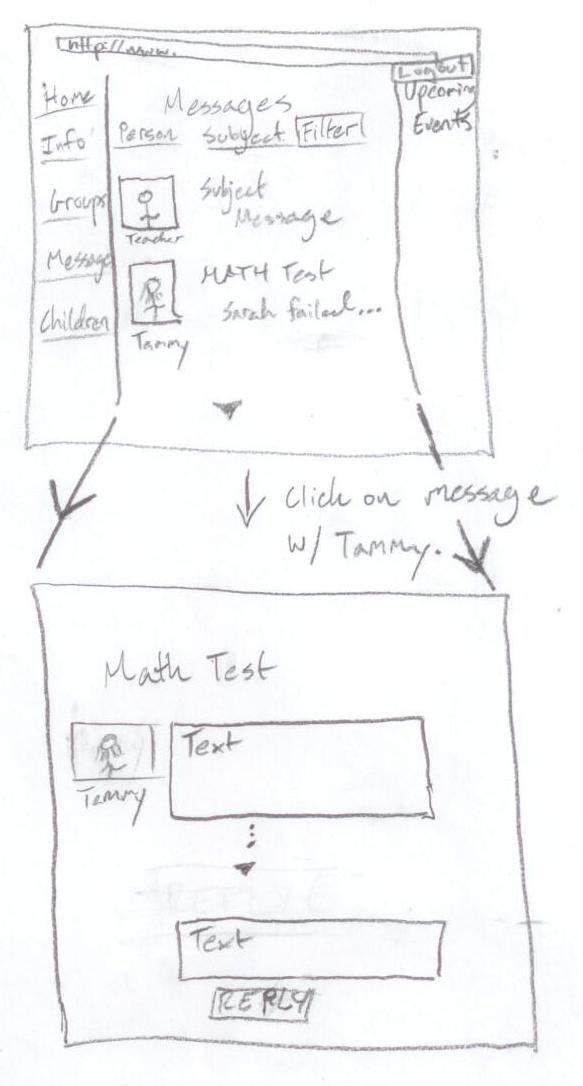
|
Main Message View
Busy Becky can now continue the conversation indefinitely by selecting the Message menu button on the left navigation bar which changes the center frame to a message screen. Here Busy Becky can view her ongoing messages and select a thread to bring up the entire conversation in the same frame.
When Busy Becky, clicks on the message with Teacher Tammy, she can see all previous messages as well as add her own response using an extremely familiar interface.
Action: The main message view allows the creation of new conversations as well as the addition of new messages to ongoing conversations. In this case, Becky decides to view an ongoing conversation to communicate with Teacher Tammy.
Description: A unified view of all messages enables users to efficiency communicate with many other users discussing potentially many student profiles. New messages appear higher in the inbox ensuring that the user can easily respond to important messages. |
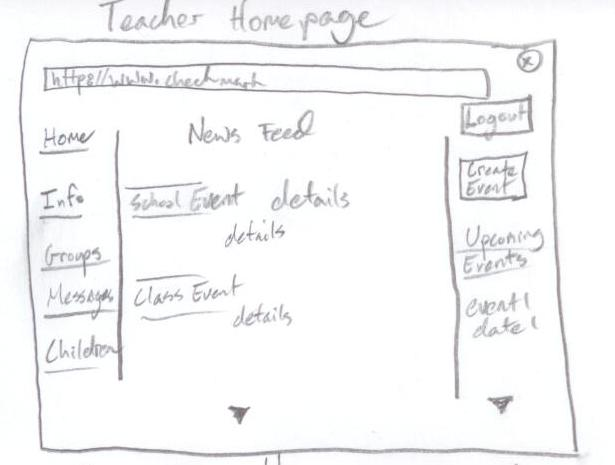
|
Teacher Home View
Now, let's see the same situation through the eyes of Teacher Tammy. Teacher Tammy logs in and is sent to a page extremely similar to the parent homepage. The major difference between the two views is a "Create Event" button that enables Tammy to create new events that will appear on the news feeds of selected students.
Action: Teacher Tammy clicks on "Groups" which leads her to the Main Groups View.
Description: The teacher homepage is really similar to the parent homepage with the exception of event creation. Only teachers can create events because allowing parents to create events could potentially overburden busy teacher's schedules. The intended use is for teachers and parents to communicate via messages and then if a meeting or event is needed, the teacher schedules it. |
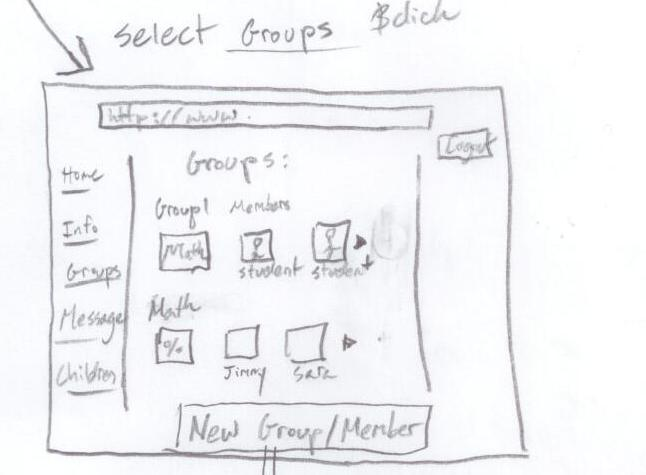
|
Main Groups View
Teacher Tammy noticed that a lot of students happened to fail her math midterm including Becky's daughter, Sarah. Teacher Tammy then decides to navigate to her Groups view which shows all the groups that Teacher Tammy is currently subscribed to.
This Group view also enables Tammy to create new groups that allow faster event creation and message reception. Teacher Tammy then decides to click on "New Group/Member" which brings up the next dialogue box.
Action: The groups view allows Tammy to dynamically create and view groups. In this case, Tammy decides to create a group.
Description: Dynamically putting students into arbitrary groups gives teachers the ability to create special study groups, project groups, etc, making messaging much more efficient. Groups can change over time as members are added and deleted.
|

|
Group Creation Dialogue
In this dialogue box, Teacher Tammy decides to create a new math study group for her many students that failed the math midterm.
First she is presented with a choice between updating a group and making a new group. She clicks on Group which highlights the bounding box and clicks "Next". She now must give a valid, not already used, name to the group and has the option of adding an icon to the group either through an image link or uploading a photo.
Finally, Tammy can select the members of the group through simple and similar user selection. She simply can to click on the student images which then highlight and allow Tammy to select multiple students. Tammy selects all of her students that failed her math midterm and then creates the new study group.
Action: Tammy follows the clear and familiar directions of the dialogue box, deciding to create a new group, giving it a name and icon, and finally populating it with members (potentially using other existing groups)
Description: Group creation allows Tammy to easily create and modify groups. She can create a new study group for the children that failed her math midterm as well as remove particular children from the group as they demonstrate their mastery of the material. Dynamic grouping saves Teacher Tammy a lot of time when messaging parents and creating events. |
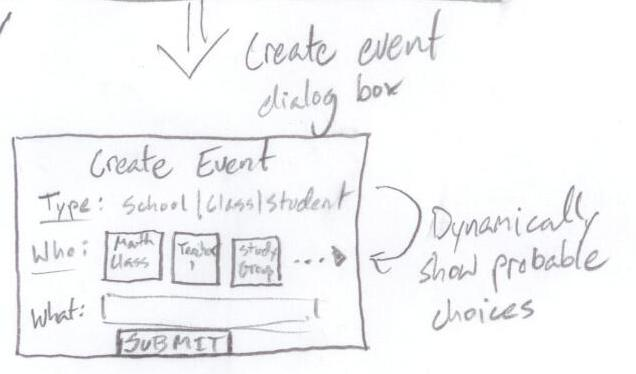
|
Event Creation Dialogue
Immediately after closing the dialogue box, without any further navigation, Teacher Tammy creates an event (study session) for her newly created group. She can now create multiple events that will appear on the desired students' news feeds. To create the event, Teacher Tammy simply must select a type of event which dynamically loads the most probable groups/students, selects the students/groups, types in an event description with as much detail as she desires, and clicks "Submit". After this sequence of events, Teacher Tammy has now setup and informed all the proper students about a study session to help her students improve.
Action: After clicking the create event button, a dialogue appears allowing Tammy to create an event with a type, a dynamically generated list of profiles, and an event description.
Description: Events act as a quick and simple way to communicate deadlines, meetings, exams, and other date-specific information. They are meant to serve as simple reminders and sparks for later messages between parents and teachers. |







